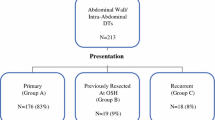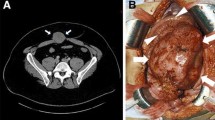Opinion statement
Because of the wide variety of anatomic locations and patient factors, there is no one treatment that is appropriate for all desmoid tumors. The type of treatment depends on tumor characteristics and location, as well as patient characteristics and preferences. Desmoid tumors can be persistent and frustrating to manage because no one treatment modality offers a high likelihood of remission. Multiple modalities may be necessary in some patients. Although mortality is rare and is usually due to local complications, significant disability or morbidity can result from desmoid tumors, their treatment, and complications arising from treatment. The entire clinical picture and the patient’s preferences must be taken into account when deciding on an appropriate treatment plan. Patients with desmoid tumors are optimally managed in a multidisciplinary setting with close collaboration between surgeon, pathologist, diagnostic radiologist, radiation oncologist, and medical oncologist. When possible, surgical resection with negative margins is the preferred modality. When surgical resection with negative margins may prove disabling, surgery can be followed by postoperative radiation, although the role and efficacy of this are controversial. In locations where surgical extirpation is difficult or unfeasible, primary radiation, hormonal therapy, or chemotherapy should be considered. Familiar adenosis polyposis (FAP)-associated mesenteric lesions, sporadic tumors present without change for months or years, or tumors present in areas where progression will not present significant additional morbidity are candidates for observation only.
Similar content being viewed by others
References and Recommended Reading
Anthony T, Rodriguez-Bigas MA, Weber TK, Petrelli NJ: Desmoid tumors. J Am Coll Surg 1996, 182:369–377.
Icard P, Le Rochais JP, Galateau F, Evrard C: Desmoid fibromatosis of the shoulder and of the upper chest wall following a clavicular fracture. Eur J Cardio Thorac Surg 1999, 15:723–725.
De Cian F, Delay E, Rudigoz RC, et al.: Desmoid tumor arising in a cesarean section scar during pregnancy: monitoring and management. Gynecol Oncol 1999, 75:145–148.
Kaplan DB, Levine EA: Desmoid tumor arising in a laparoscopic trocar site. Am Surg 1998, 64:388–390.
Clark SK, Phillips RK: Desmoids in familial adenomatous polyposis. Br J Surg 1996, 83:1494–1504. A review of 166 desmoids in 88 patients is presented. The authors find that while abdominal wall desmoids caused no death and little morbidity, intra-abdominal desmoids can cause serious complications, and treatment is often unsuccessful.
Heiskanen I, Jarvinen HJ: Occurrence of desmoid tumours in familial adenomatous polyposis and results of treatment. Int J Colorectal Dis 1996, 11:157–162.
Vandevenne JE, De Schepper AM, De Beuckeleer L, et al.: New concepts in understanding evolution of desmoid tumors: MR imaging of 30 lesions. European Radiology 1997, 7:1013–1019.
Maurer F, Horst F, Pfannenberg C, Wehrmann M: Multifocal extra-abdominal desmoid tumor diagnostic and therapeutic problems. Arch Orthop Trauma Surg 1996, 115:359–362.
Sabate JM, Parellada JA, Franquet T, et al.: Metachronous multicentric aggressive fibromatosis with mediastinal involvement. Eur Radiol 1996, 6:207–209.
Gaposchkin CG, Bilsky MH, Ginsberg R, Brennan MF: Function-sparing surgery for desmoid tumors and other low-grade fibrosarcomas involving the brachial plexus. Neurosurgery 1998, 42:1297–301.
Merchant NB, Lewis JJ, Woodruff JM, et al.: Extremity and trunk desmoid tumors: a multifactorial analysis of outcome. Cancer 1999, 86:2045–2052. One hundred and five patients with desmoid tumor are reviewed. The authors note that in their series, age, gender, depth of tumor, size of tumor or tumor site, and positive margin are not predictions of local recurrence.
Spear MA, Jennings LC, Mankin HJ, et al.: Individualizing management of aggressive fibromatoses. Int J Radiat Oncol Biol Phys 1998, 40:637–645. This study reviewed 107 fibromatosis cases. The authors recommend radiation following surgery with positive margins, or for tumors in which resection would result in significant functional or cosmetic defects.
Spiegel DA, Dormans JP, Meyer JS, et al.: Aggressive fibromatosis from infancy to adolescence. J Pediatr Orthop 1999, 19:776–784.
Patel SR, Evans HL, Benjamin RS: Combination chemotherapy in adult desmoid tumors. Cancer 1993, 72:3244–3247.
Fernberg JO, Brosjo O, Larsson O, et al.: Interferoninduced remission in aggressive fibromatosis of the lower extremity. Acta Oncol 1999, 38:971–972.
Leithner A, Schnack B, Katterschafka T, et al.: Treatment of extra-abdominal desmoid tumors with interferonalpha with or without tretinoin. J Surg Oncol 2000, 73:21–25.
Weiss AJ, Horowitz S, Lackman RD, Lackman RD: Therapy of desmoid tumors and fibromatosis using vinorelbine. Am J Clin Oncol 1999, 22:193–195.
Skapek SX, Hawk BJ, Hoffer FA, et al.: Combination chemotherapy using vinblastine and methotrexate for the treatment of progressive desmoid tumor in children. J Clin Oncol 1998, 16:3021–3027.
Izes JK, Zinman LN, Larsen CR: Regression of large pelvic desmoid tumor by tamoxifen and sulindac. Urology 1996, 47:756–759.
Benson JR, Mokbel K, Baum M: Management of desmoid tumours including a case report of toremifene. Ann Oncol 1994, 5:173–177.
Suit H, Spiro I: Radiation as a therapeutic modality in sarcomas of the soft tissue. Hematol Oncol Clin North Am 1995, 9:733–746.
Kamath SS, Parsons JT, Marcus RB, et al.: Radiotherapy for local control of aggressive fibromatosis. Int J Radiat Oncol Biol Phys 1996, 36:325–328.
Pritchard DJ, Nascimento AG, Petersen IA: Local control of extra-abdominal desmoid tumors. J Bone Joint Surg 1996, 78:848–854. Fifty patients treated for desmoid tumor were reviewed and treated with surgery, radiation, both surgery and radiation, or observation. No patients died of disease.
Ballo MT, Zagars GK, Pollack A: Radiation therapy in the management of desmoid tumors. Int J Radiat Oncol Biol Phys 1998, 42:1007–1014. The outcome of 189 patients treated for desmoid tumor who received radiation is retrospectively reviewed. The authors conclude that radiation is an effective modality and should be recommended following positive-margin surgery, or for unresectable tumors.
Goy BW, Lee SP, Fu YS, et al.: Treatment results of unresected or partially resected desmoid tumors. Am J Clin Oncol 1998, 21:584–590.
Shin KH, Shin SJ, Lee DH, et al.: The role of radiotherapy in the treatment of aggressive fibromatosis. Yonsei Med J 1999, 40:439–443.
Faulkner LB, Hajdu SI, Kher U, et al.: Pediatric desmoid tumor: retrospective analysis of 63 cases. J Clin Oncol 1995, 13:2813–2818.
Mahoney J, Bell RH, Hudson AR, et al.: Aggressive fibrous tissue lesions in the upper extremity: treatment and results. J Hand Surg Am 1994, 19:686–693.
Ballo MT, Zagars GK, Pollack A, et al.: Desmoid tumor: prognostic factors and outcome after surgery, radiation therapy, or combined surgery and radiation therapy. J Clin Oncol 1999, 17:158–167.
Higaki S, Tateishi A, Ohno T, et al.: Surgical treatment of extra-abdominal desmoid tumours (aggressive fibromatoses). Int Orthop 1995, 19:383–389.
Lev-Chelouche D, Abu-Abeid S, Nakache R, et al.: Limb desmoid tumors: a possible role for isolated limb perfusion with tumor necrosis factor-alpha and melphalan. Surgery 1999, 126:963–967.
Author information
Authors and Affiliations
Rights and permissions
About this article
Cite this article
Biermann, J.S. Desmoid tumors. Curr. Treat. Options in Oncol. 1, 262–266 (2000). https://doi.org/10.1007/s11864-000-0038-5
Issue Date:
DOI: https://doi.org/10.1007/s11864-000-0038-5




